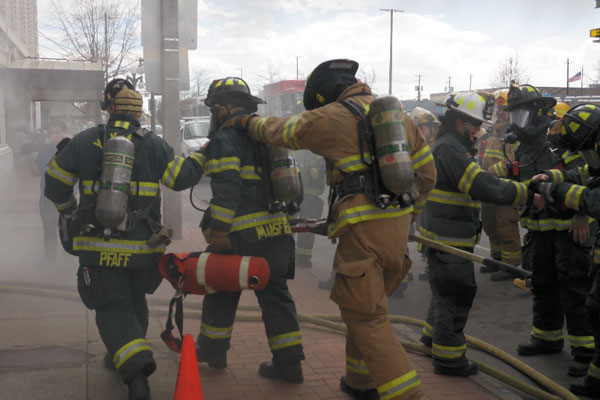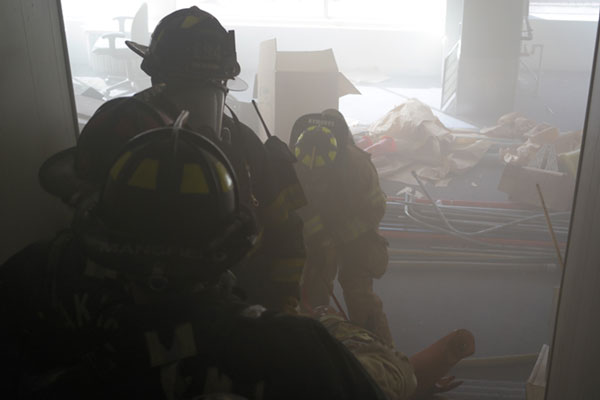
By Alex Langbell
Earlier this year, the Yakima (WA) Fire Department Training Division (YFDTD) conducted drills at an unoccupied commercial occupancy in downtown Yakima. The drill was loosely designed after a fire fatality that occurred in Phoenix, Arizona, in which a firefighter became disoriented in heavy smoke conditions that were present in a commercial fire which led to his death. The YFDTD decided to recreate a similar drill to evaluate how we would perform in this highly stressful situation.
Fire cadets from the local college fire program along with practice manikins were used as victims. In the first two drills, crews face pieces were blacked out completely, whereas the last drill, heavy smoke conditions were recreated with smoke machines. This was done to evaluate how crews would perform in various smoke conditions. Electric portable speakers and smoke detectors were used throughout the structure to simulate the audio interference that would be present in a commercial structure. Charged hoselines where extended throughout the structure with running apparatus and generators strategically placed outside the structure to recreate the external noise found at a fire incident. Five agencies, 28 engine and truck companies, 97 firefighters/officers, two chief officers, and four evaluators took place in the three-day drill. News media was present at two of the drills.
The Scenario
Yakima Fire Department crews were dispatched to a three-story commercial structure with light smoke. First companies on scene find a three-story commercial structure (approximately 10,000 square feet) with light smoke showing from second-floor window. Upon arrival of the first two companies and command unit, one crew was sent in on a hoseline for investigation. The second crew became the standby team and the shift commander established command. Smoke conditions worsened on the second floor as attack team searched for fire. A third apparatus appears to serve as the rapid intervention team (RIT). The standby team transitioned to the backup team and entered to assist the attack team. Command called for a second alarm. Multiple apparatus arrived on scene but the fire was still unable to be located. Heavy smoke conditions built and, due to breathing air supply, crews were forced to exit the structure. The backup team was unable to make contact with attack team and exited the structure with their low-air alarms sounding. After unsuccessful attempts to contact the attack team, a Mayday was called by the incident commander (IC) and RIT was launched. The IC appointed a rescue group leader and assigned multiple companies to the rescue group. At this point the drills began.
After conducting the drills and then going back and reading the report from the Phoenix Fire Department on many of the problems that they faced, the list was almost a mirror image of what we as a department faced and need to improve on. The following are some of the major problems we identified and what crews need to do to improve.
1) Personal Alert Safety System (PASS) Device Activation: This is by far the biggest problem the YFDTD identified. Search crews forgot about or did not stop to listen for PASS devices. At one point there were two crews within 15 feet of one of the victim and he was not identified for several minutes. During the debriefing after the drill, one firefighter commented that he had heard the alarm sounding but thought it was one of this own guys. Also, with the addition of smoke detectors sounding, some crews mistakenly thought that the smoke detector was a PASS device for a brief period of time, leading them in a different direction.
How to improve: All crews need to activate and become familiar with the sound of their PASS device. The alarm should be activated on a regular basis. PASS device drills should be conducted.
2) Communication: As usual, communication found its way to the top of the list. This is one area that will always be a challenge and must continuously be improved on. Communication was a difficult because of several factors. Internal audio, portables that where not transmitting or receiving, excessive traffic from command staff, and scanning radio traffic also led to the inability to hear or listen for PASS devices. Also, communication between crews inside the structure was a concern.
How to improve: Rescue group leaders were aggressively contacting crews, which interrupted them from performing their tasks at times. Understandably, rescue group leaders and ICs managing the incident are extremely concerned about sending additional crews in and risking additional casualties. It was evident it slowed down the rescue efforts by making officers stop their crew from searching or accomplishing a task and giving a CAN report. Rescue group leaders and ICs need to trust their crews to give them updates as crews make progress through the structure. Interior company officers need to convey accurate reports on a timely manner, including when conditions change, when their location changes, or any other pertinent information that the IC or rescue group leaders might need. Officers simply need to respond “Standby” to the rescue group leader or IC if they are in the middle of completing a task. This at least lets the rescue group leader or IC know, “Okay they are still there; they are communicating with me.”
Portable radios: This is difficult due to the fact we are relying on a mechanical piece of equipment sending a signal into a concrete structure with various levels of interference. As an interior rescue crew, as long as you have your crew monitoring the designated radio frequency you can request the rescue group leader to switch to direct line of sight on one portable when you are entering a problem area such as a basement. The rescue group leader can designate a second portable as direct line of sight for those crews who are operating in areas of difficult radio communication. Rescue group leaders should be monitoring two portables. Make sure interior crews portables are not scanning. This was a major problem when trying to communicate and listen for PASS devices. Talk clearly and concisely when taking to the rescue group leader or IC, thereby keeping radio traffic to a minimum. Also, make certain your portables are working without any issues upon start of your shift and replace any that give you the slightest problem
Interior Crews: When crews are working together and there is an exchange of information or if crews are there to assist with victim removal, it is paramount that officers take control and exchange clear and complete communication quickly with other interior officers. When passing in tight quarters such as hallways and stairwells, it is critical that good communication is conducted, especially when hauling out a victim. An example:
“We will pass on left, you pass on right.”
“Lead us out, we have the victim.”
“We searched the room at the end of our rope line and found nothing. We have not gone up stairs.”
3) Effective use of equipment: Another significant problem identified was the use of equipment in an environment where visibility is virtually nonexistent. Rope bags were not secured properly or used correctly. RIT one-hour bottles were not used efficiently , thereby wasting precious minutes. Thermal imaging cameras, when allowed to be used in the last drill, were not used effectively.
How to correct: Make certain you secure the rope bag to an exterior unmovable object (not the door). Make certain to keep the rope tight at all times and secure the rope to the last location in the structure you reached. Leave it there if you exit so that incoming crews know which area you last searched. Too many ropes inside a structure created a problem at times. Drill in blackout conditions.
With regard to the RIT one-hour bottle, firefighters must practice (in blackout conditions) connecting bottles on victims and firefighters who have used their air and need to supplement. Remember, these bottles can be used if you don’t manage your air properly and have to supplement your own air to get out of the structure. In all scenarios, practice working and communicating together as you secure air supply.

*
The purpose of this drill was to identify how effective we would be in one of the most difficult situation our department(s) might face. Overall, we feel we did some really good things, but we have to look at our complete performance and make a conscious effort to improve on our weaknesses. We have to approach large-area commercial rescue scenarios differently than residential civilian searches. Rather than a systematic search of the immediate area upon entering the structure, the goal is to locate down or lost firefighters immediately. The best way to accomplish this is by getting to the end of the hoseline and beginning your systematic search from there. Additional crews must be ready to assist when firefighters are located or to continue the search if initial rescue crews expend their air supply.
A quick removal of the victim must be performed and can be accomplished by having two crews assist with removal. There needs to be personnel guiding the crews out of the structure to prevent firefighters from getting injured, such as falling downstairs, and/or getting disoriented and lost. If you do find yourself lost, immediately call for a Mayday. The time you spend protecting your pride and searching for your own way out can be costly when it comes to air management and personal survival.
Alex Langbell is a lieutenant with the Yakima (WA) Fire Department.
MORE TRAINING BULLETINS

